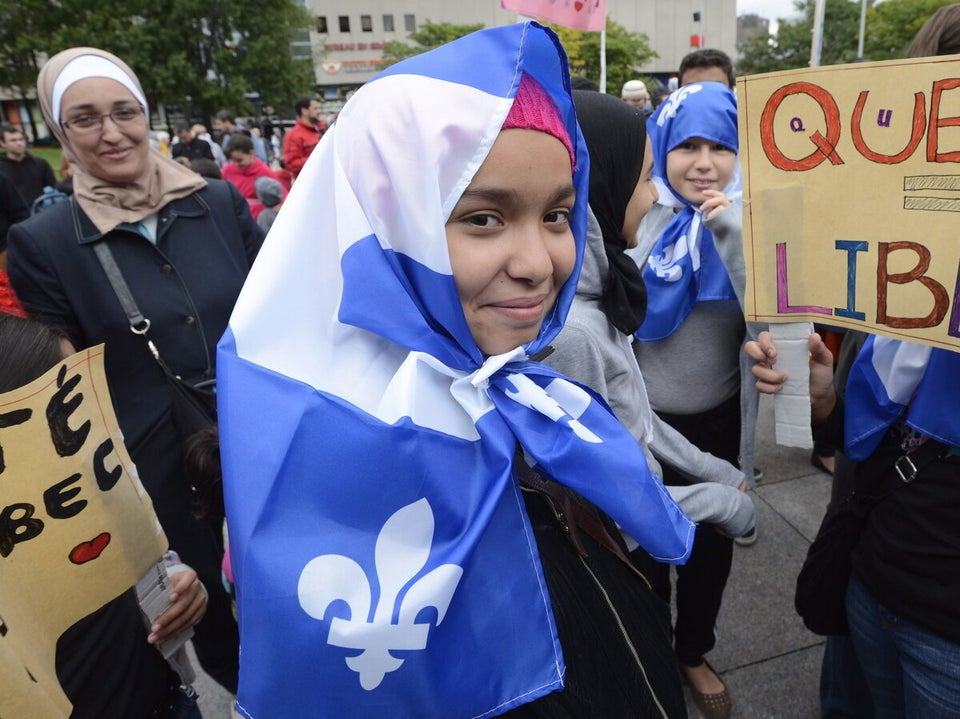By: Isabelle Bourgeault-Tassé
A storm is brewing in Montreal, Canada's most fashionable city.
The provincial state, which famously stayed out of the bedrooms of the nation in 1967, has instead elected to rifle through its citizens closets.
In the spring, a ban on turbans on Quebec's soccer fields set off a firestorm that even FIFA couldn't quell. And in late August, a leaked memo revealed plans by the ruling Parti Québécois to introduce the Quebec Charter of Values, which would ban all so-called "ostentatious" religious symbols -- the Islamic veil, the Sikh turban, the Jewish Kippah, and large Christian crosses -- from public life.
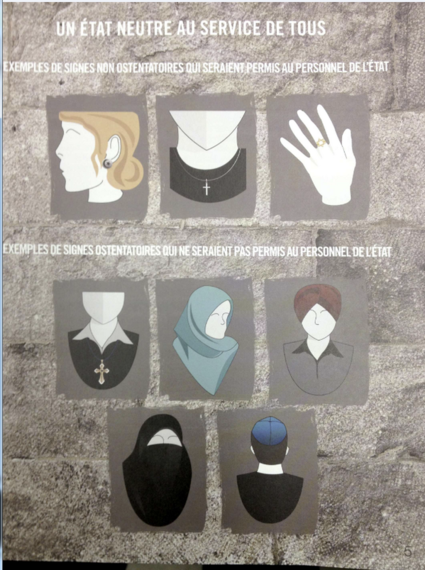
Government of Quebec's signage indicating what's allowed (top) and what's not (bottom).
But it quickly became apparent that the hijab, the Islamic veil worn as an act of modesty and often as a stylish cultural fashion statement, was the controversy's real bone of contention.
And feminists of all stripes have rallied to the cause. Some have argued that the veil is a garment of oppression that has no place in a secular and democratic society, suggesting that Muslim women need to be saved. Other feminists maintain that the ban stigmatizes and marginalizes Muslim women.
In a recent debate about the Quebec Charter of Values, author and pundit Djemila Benhabib squared off against sociology student Dalila Awada to talk hijabs. Benhabib argued that the veil is a sexist garment that casts women as temptresses and men as predators. It is, she says, a symbol stained with the blood of thousands of women forced to wear it.
Awada's retort struck at the heart of the debate: "As a Muslim Québécoise, I should not have to shoulder the burden of what's happening around the globe." It's critical, she continues, to think about the veil in its North American context, where the social and political situation of women is different.
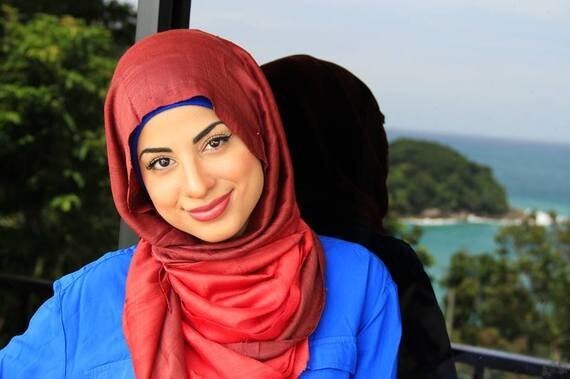
Dalila Awad
Rima Demanins, a young Montrealer who does not wear the veil, recently echoed Awada's sentiment, writing in the Montreal Gazette: "I do not deny the oppression of women elsewhere, but this is not the case in our province: Quebec women have long fought for gender equality and I would be the first to raise my voice if I felt that it were threatened."
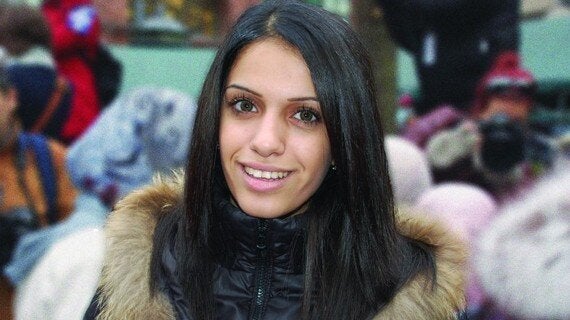
Rima Demanins
But Quebec's Muslim women have been threatened -- violence against veiled women has increased dramatically since the Charter debate was introduced. And the perpetrators are none other than their fellow Quebecers, the same people who have long decried violence against women. One veiled woman was verbally assaulted on a city bus, while another veiled woman faced violent demands to remove her veil at a shopping mall.
Other Muslim women, like Awada, have even been openly mocked, with high profile comedienne Denise_Filiatrault decrying that she was painted up like a clown during a high-profile television interview, and referring to all veiled women as "crazy."
Pundit Djemila Benhabib is right in some respects -- from Iran to Afghanistan, Algeria to Saudi Arabia, the veil is and has been law, and indeed been used as an instrument of oppression by religious and political authorities. Some women have been persecuted, or even killed for challenging tradition and deeply entrenched social norms -- the veil, in all its forms, has been part and parcel of that rebellion.
But Benhabib also skipped over the veil's role as a symbol of resistance during Iran's 1979 Revolution, for example, when women took to the streets of Tehran wearing the veil, or chador. While some women wore the veil, or chador, as a means of solidarity with Ayatollah Khomeini, who called the chador the 'flag of the revolution,' many women also wore it as a mark of opposition to Mohammad Reza Shah Pahlavi's repressive and extravagant regime. Iranian religious authorities would soon impose the veil, but women again descended into the streets to take the theocracy to task. And while they lost this battle, Khomeini should perhaps have seen this coming: women had marched in protest when Reza Shah abolished the veil in an effort to modernize Iran in 1936.
The bottom line: Iran's women were not willing to wear or cast aside the chador, nor were they willing to dwell beneath the thumb of a heavy-handed stated.
Like the women of Iran, Quebec's Hijabistas are unwilling to allow the Quebec provincial government to consolidate the foundations of its political power on their backs.
In Quebec, the issue of choice and self-determination around the veil is critical. As Harvard University Professor Leila Ahmed, author of A Quiet Revolution: The Veil's Resurgence, from the Middle East to America, recently told the Guardian: "The key issue is whether a woman is required to wear the abaya by law. If they are free to choose, you could certainly argue the bikini is no more sexist than the abaya: they are both constructions of the female body."
Anthropologist Lila Abu-Lughod takes it one step further, writing, "If we think that U.S. women live in a world of choice regarding clothing, we need to look no further than our own codes of dress and the often constricting tyrannies of fashion."
It would seem, then, that in matters of fashion, religion, and secularism, Montreal's Muslim women are being held to a higher standard by their provincial government.
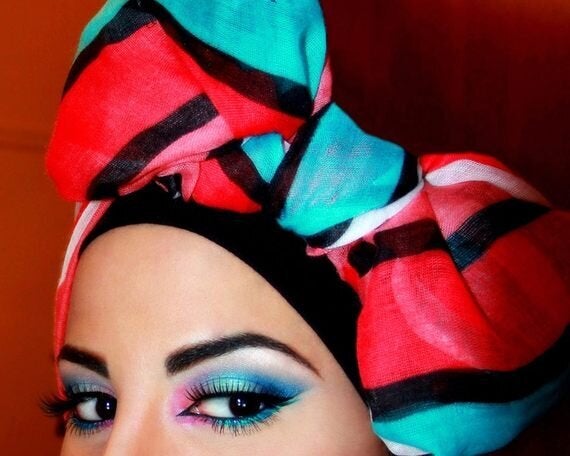
Dalila Awada
So in Montreal and more widely across Quebec, where women have historically been among the first to go to the barricades for their rights and, most importantly, where women wear the veil by choice, does the hijab equal oppression? Must the state save "oppressed" Muslim women by controlling women's bodies, a coercive tactic long decried by feminists? Or is this a manifestation of Islamophobia, wedge politics, or a crusade to preserve Quebecois culture?
Or perhaps Muslim feminists are right when they say: ne me libère pas -- je m'en charge. No need to save me -- I've got this.
So, what do Montreal's Hijabistas think of all this?
On a chilly Sunday afternoon, Ramp 1885 took to the streets of Montreal during a protest organized by AMAL-Québec, the Congrès Maghrébin Au Québec, and Québécois musulmans pour les droits et libertés to talk to young women about the veil. Amid joyful ululations, rallying political cries, and French Canadian folk music, Montreal's young Hijabistas -- and those who support them -- told us what the veil means to them.
Feminists, too
"It's my life. It's my belief. It's mine. And I don't think that anyone has the right to say "take off your veil." It's up to me to ask myself if it's right for me. And if people say that we're submissive women, we're here and we say "no, we're not submissive." Not at all. We're educated people, and we wear the veil by choice. It's our conviction. And we're feminists too. Muslim women are also women -- you can't exclude them, you can't cast them aside." Meriem - age 26
Women's freedom
"I've lived in Montreal for over 20 years -- I've watched the city's face change, and it's never bothered me. I carried a lot of feminist posters in the 1980s. I have always fought for the freedom of women. Of all women. And I don't see how, as a Western woman, I could use a paternalistic tone on women who are different than me." Marie - age 66
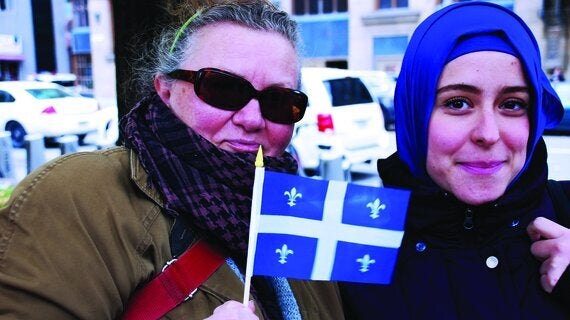
Marie and Meriam
An aspiration and a journey
"I think it is part of a larger spiritual journey for us Muslim women. For me, at this very moment in time, it's not a necessity. But it's something to which I might aspire one day -- maybe one day, I'll wear the veil. For me, it represents the final step in my spirituality." Rima Demanins - age 20
Rima Demanins is a volunteer with Québécois musulmans pour les droits et libertés. Rima has written in defense of the veil, the struggles of veiled women, and told the story of how her mother came to wear the hijab against her father's wishes.
My identity
"The veil is my identity, my way of showing myself to people. It's a lifestyle, it's my way of telling people who I am." Fatima - age 18
Alienating Muslim women
"I think we have to stop asking Muslim women why they wear the veil. Every time a Muslim woman is asked to talk about an issue in the media, it's always and only in relation to her veil. And I think we always emphasize that she's different and -- whether it's done consciously or unconsciously -- it's a process through which we also alienate her." Dania Suleman - age 25
A woman's choice
"Every veiled woman has her own reasons for wearing the veil. What's most important is to respect the choice that women make when they wear the veil. We can respect women's choices: what they want, what they don't want. If they want to wear the veil -- for fashion, culture, religious, or whatever reason -- we must give them that choice. And that's why I'm here today -- I think it's important to fight for those rights." Baya Touré - age 24
Baya Touré and Dania Suleman are friends and volunteers at AMAL. Under the proposed Charter, Suleman -- a lawyer -- would not be allowed to plead in a Quebec court of law.
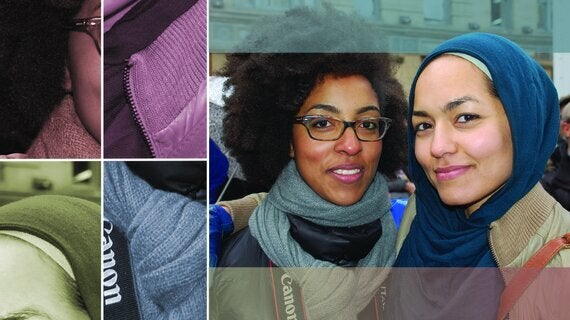
Baya Toure (left) and Dania Suleman
Freedom and humility
"To me, the veil is first and foremost a symbol of religious identity. It's a symbol of humility. It's a symbol that represents the simplicity of women. When I wear the veil, I focus on who I am as a person, rather than on my exterior. So, for me, it's a way of living my spirituality while living in a Western society, while having a very modern life and freedom, but with simplicity, humility, and modesty." Asma - age 27
Modesty and fashion
"For me, the veil is a form of modesty. In my view, the Muslim veil isn't set in stone. It has a broader meaning; it can be interpreted in many ways. I live the veil in my own way: I cover my head, and, as a Western woman who loves fashion, I try to dress modestly while remaining stylish and respecting my femininity. But there you have it -- for me, it's a form of modesty." Zeynab - age 26
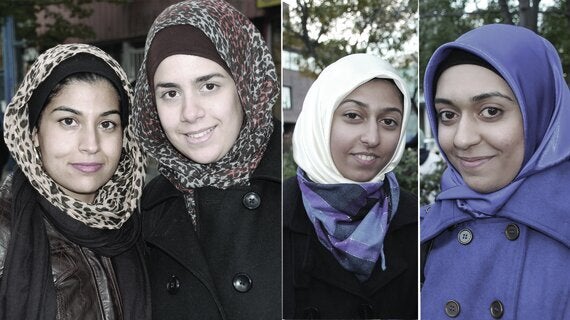
(L-R): Zeynab, Asma, Sarah & Fatima
A part of me
"For me, it's about my identity. It's the way I dress. It's more than an ostentatious symbol. My headscarf -- I can't take it off. I don't play with that. I can't go to work and not wear it. When I go out into the street, I wear it. It's something that I wear at all times, always. And it's a part of me." Zoubida - age 18
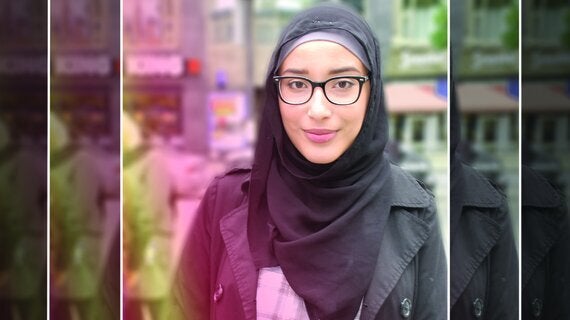
Zoubida
A long journey
"It's a long journey, that's for sure. The reasons I wear the veil today probably won't be the same five years from now. My reasons change continuously. Today, it's a personal tool -- a reminder that adds value to my faith that reminds me how I want to interact with others, while being respectful of them, and as modest as possible. It's very spiritual, very cultural; there are many factors at play for which every woman wears the veil as she sees fit." Dalila Awada- age 22
Dalila Awada is a sociology student at the Université du Québec à Montréal (UQÀM). She has been an outspoken defender of women's freedom to wear the veil. Under the Charter, Awada -- who wants to teach -- would not be permitted inside a classroom with her hijab.
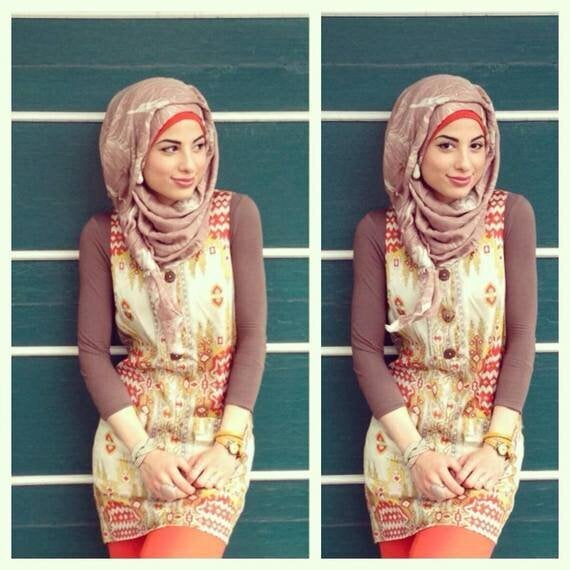
Dalila Awad
Read the full, unedited quotes (in Frenchhttp://isabellebourgeault-tasse.tumblr.com).
Photography by Isabelle Bourgeoult-Tassé; photo editing by Adam Clark (Rima Demanins; Marie and Meriam; Baya Touré and Dania Suleman; Zeynab, Asma, Sarah, and Fatima; and Zoubida). All other profile photography provided by the subjects interviewed.
ALSO ON HUFFPOST:
